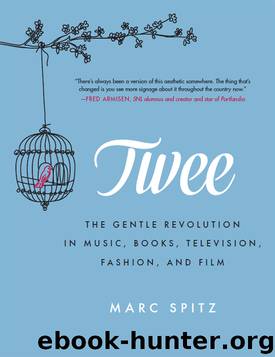Twee : The Gentle Revolution in Music, Books, Television, Fashion and Film (9780062213051) by Spitz Marc

Author:Spitz, Marc
Language: eng
Format: epub, mobi
Publisher: HarperCollins
Chapter 9
“You’re in High School Again”
1988–1995
This chapter is about Nirvana. In addition to being many other important things, Nirvana was Twee. When Kurt Cobain was alive, he often went out of his way to prove this, so when you say to yourself, “Wait, Nirvana wasn’t Twee, not at all,” think of Kurt and how he would feel if he overheard you.
Everybody loved Nirvana,” says Sean Nelson, the former Harvey Danger front man who relocated to the Seattle area in the late 1980s. “And everybody’s reaction to Nirvana grew to be, ‘Nobody else understands them like I do. Everybody loves Nirvana, but those people are assholes, and I really get it.’ They were the first band where the best way to express your fandom was to not wear their T-shirt.” For a brilliant band, Nirvana had pretty shitty merchandise: their signature shirt was an oversize black tee with a big, yellow, crooked-smile happy face. Who would wear that anyway, if you were a cool and righteous Indie Punk? “It’s part of the Olympian strain of simply not participating in mass culture,” Nelson continues. “It was an easy act to cop: ‘Oh, mass culture and MTV doesn’t represent me in any way. I don’t recognize myself in it. I don’t know who the Gin Blossoms are.’ Of course you know who the Gin Blossoms are. You’ve been in a supermarket! Kurt was just swaddled with shame for having any mainstream success and he went out of his way to shit on that world.”
Nirvana often gets credit for taking the fundamentally intimate and manageable aesthetic of Indie or Twee and, depending on whom you ask, either triumphing over its limitations of reach and appeal or ruining it forever. But at the end of the 1980s, this shift was already under way in music with the audience expansion enjoyed by the Smiths, R.E.M., and the Cure (who had their Twee moments with singles like “The Love Cats” and “The Caterpillar”). John Hughes primed the mainstream for a sometimes reluctant acceptance of the shy, the clever, the vintage clad. The Hughes trilogy of Sixteen Candles, The Breakfast Club, and Pretty in Pink—and the bands that gibed with his vision, the Smiths among them—was a kind of Trojan horse for Indie; these were, after all, Hollywood films designed to reach mass audiences and make millions of dollars, suffused with a sensibility intended to self-limit. In the wake of Hughes and Pee-wee Herman came a sort of new mainstream: one with edge.
The era had its superstars—Prince, Madonna, Cyndi Lauper, Whitney Houston, and the King of Pop, Michael Jackson—and it had its cult heroes—the Cure, Depeche Mode, R.E.M., and the Smiths. At the start of the decade there seemed to be some kind of commercial moat between the two. As the ’80s wore on, that divide dried up and a growing hunger for smarter, shyer, sadder pop stars who reflected real teenage emotion, anger, and confusion increased wildly. While Nirvana was still trying to emulate the Melvins, edge—that
Download
Twee : The Gentle Revolution in Music, Books, Television, Fashion and Film (9780062213051) by Spitz Marc.mobi
This site does not store any files on its server. We only index and link to content provided by other sites. Please contact the content providers to delete copyright contents if any and email us, we'll remove relevant links or contents immediately.
Cecilia; Or, Memoirs of an Heiress — Volume 1 by Fanny Burney(32412)
Cecilia; Or, Memoirs of an Heiress — Volume 3 by Fanny Burney(31822)
Cecilia; Or, Memoirs of an Heiress — Volume 2 by Fanny Burney(31801)
The Great Music City by Andrea Baker(31249)
We're Going to Need More Wine by Gabrielle Union(18951)
All the Missing Girls by Megan Miranda(15491)
Pimp by Iceberg Slim(14319)
Bombshells: Glamour Girls of a Lifetime by Sullivan Steve(13952)
Talking to Strangers by Malcolm Gladwell(13185)
Norse Mythology by Gaiman Neil(13170)
Fifty Shades Freed by E L James(13145)
For the Love of Europe by Rick Steves(12644)
Mindhunter: Inside the FBI's Elite Serial Crime Unit by John E. Douglas & Mark Olshaker(9160)
Crazy Rich Asians by Kevin Kwan(9147)
The Lost Art of Listening by Michael P. Nichols(7388)
Enlightenment Now: The Case for Reason, Science, Humanism, and Progress by Steven Pinker(7163)
The Four Agreements by Don Miguel Ruiz(6597)
Bad Blood by John Carreyrou(6519)
Weapons of Math Destruction by Cathy O'Neil(6116)
